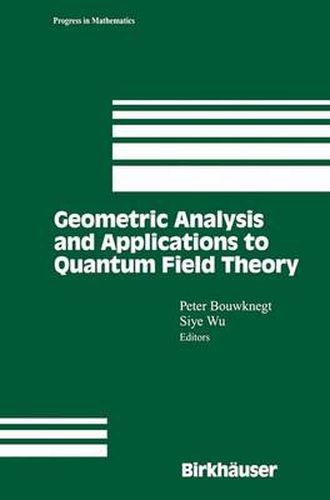Readings Newsletter
Become a Readings Member to make your shopping experience even easier.
Sign in or sign up for free!
You’re not far away from qualifying for FREE standard shipping within Australia
You’ve qualified for FREE standard shipping within Australia
The cart is loading…






This title is printed to order. This book may have been self-published. If so, we cannot guarantee the quality of the content. In the main most books will have gone through the editing process however some may not. We therefore suggest that you be aware of this before ordering this book. If in doubt check either the author or publisher’s details as we are unable to accept any returns unless they are faulty. Please contact us if you have any questions.
In the last decade there has been an extraordinary confluence of
ideas in mathematics and theoretical physics brought about by
pioneering discoveries in geometry and analysis. The various chapters
in this volume, treating the interface of geometric analysis and
mathematical physics, represent current research interests. No
suitable succinct account of the material is available elsewhere.
Key topics include:
* A self-contained derivation of the partition function of Chern-
Simons gauge theory in the semiclassical approximation (D.H. Adams)
* Algebraic and geometric aspects of the Knizhnik-Zamolodchikov
equations in conformal field theory (P. Bouwknegt)
* Application of the representation theory of loop groups to simple
models in quantum field theory and to certain integrable systems (A.L.
Carey and E. Langmann)
* A study of variational methods in Hermitian geometry from the
viewpoint of the critical points of action functionals together with
physical backgrounds (A. Harris)
* A review of monopoles in nonabelian gauge theories (M.K. Murray)
* Exciting developments in quantum cohomology (Y. Ruan)
* The physics origin of Seiberg-Witten equations in 4-manifold theory
(S. Wu)
Graduate students, mathematicians and mathematical physicists in
the above-mentioned areas will benefit from the user-friendly
introductory style of each chapter as well as the comprehensive
bibliographies provided for each topic. Prerequisite knowledge is
minimal since sufficient background material motivates each chapter.
$9.00 standard shipping within Australia
FREE standard shipping within Australia for orders over $100.00
Express & International shipping calculated at checkout
This title is printed to order. This book may have been self-published. If so, we cannot guarantee the quality of the content. In the main most books will have gone through the editing process however some may not. We therefore suggest that you be aware of this before ordering this book. If in doubt check either the author or publisher’s details as we are unable to accept any returns unless they are faulty. Please contact us if you have any questions.
In the last decade there has been an extraordinary confluence of
ideas in mathematics and theoretical physics brought about by
pioneering discoveries in geometry and analysis. The various chapters
in this volume, treating the interface of geometric analysis and
mathematical physics, represent current research interests. No
suitable succinct account of the material is available elsewhere.
Key topics include:
* A self-contained derivation of the partition function of Chern-
Simons gauge theory in the semiclassical approximation (D.H. Adams)
* Algebraic and geometric aspects of the Knizhnik-Zamolodchikov
equations in conformal field theory (P. Bouwknegt)
* Application of the representation theory of loop groups to simple
models in quantum field theory and to certain integrable systems (A.L.
Carey and E. Langmann)
* A study of variational methods in Hermitian geometry from the
viewpoint of the critical points of action functionals together with
physical backgrounds (A. Harris)
* A review of monopoles in nonabelian gauge theories (M.K. Murray)
* Exciting developments in quantum cohomology (Y. Ruan)
* The physics origin of Seiberg-Witten equations in 4-manifold theory
(S. Wu)
Graduate students, mathematicians and mathematical physicists in
the above-mentioned areas will benefit from the user-friendly
introductory style of each chapter as well as the comprehensive
bibliographies provided for each topic. Prerequisite knowledge is
minimal since sufficient background material motivates each chapter.